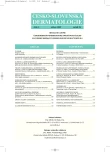-
Medical journals
- Career
Oxidated Cellulose in the Therapy of Chronic Leg Ulcers – Results of Clinical Study
Authors: V. Slonková; V. Vašků
Authors‘ workplace: I. dermatovenerologická klinika FN U sv. Anny v Brně a LF MU přednosta doc. MUDr. Vladimír Vašků, CSc.
Published in: Čes-slov Derm, 84, 2009, No. 2, p. 92-98
Category: Pharmacologyand Therapy, Clinical Trials
Overview
Objective:
Safety and effectivity of oxidated cellulose (OC) in the therapy of chronic leg ulcers were evaluated at the First Department of Dermatovenereology of the St. Anna University Hospital in Brno during years 2006–2007.Material and methods:
30 patients with chronic leg ulcers of venous or mixed aetiology lasting for longer than 3 months and without response to standard therapy were involved in the study. Half of patients was treated with the hydrogencalcium salt of oxidized cellulose (group 1), the second half was treated with the pure oxidized cellulose (group 2). Both groups were statistically comparable (mean age, size and duration of ulcers). OC were applied once in 1–3 days for the period of 2 months. Healing was evaluated weekly.Results:
Double-way ANOVA method was used to evaluate the length of therapy and the effect of therapy depending on the used OC type. After 2 weeks the statistically significant decrease of ulceration size was observed in both patient groups, while in the group 1 the continuous decrease was seen – the reduction of initial size of ulcerations were statistically significant after 3 weeks as well. Similarly, the statistically significant decrease of relative pain value in both groups was observed mostly in the group 1. In this group the pain was significantly lower after the first and the fourth week of therapy.Conclusion:
Both types of OC accelerate chronic leg ulcers healing especially influencing granulation and epithelisation. After 1 week the pain relief is already evident thus improving the quality of life even before wound closure. Statistical evaluation showed better results in patients treated with the hydrogencalcium salt of OC.Key words:
oxidized cellulose – leg ulcers – wound healing – quality of life
Sources
1. Briggs, M., Torra, J.E. Pain at wound dressing changes: a guide to management. EWMA Position Document: Pain at wound dressing changes, 2002, p. 12-17.
2. Harrison, M.B., Graham, I.D., Friedberg, E., Lorimer, K., Vandevelde, C.S. Assessing the population with leg and foot ulcers. Canadian Nurse, 2001, 97, p. 18-23.
3. Hofman, D., Wilson, J., Poore, S., et al. A pilot study using a new dressing material: Traumacel. J Wound Care, 2000, 9, p. 393-396.
4. Hughes, M.A., Yang, Y., Cherry, G.W. Effect of Traumacel P on the growth of human dermal fibroblasts in vitro. J Wound Care, 2002, 11, p. 149-154.
5. Hyland, M.E., Ley, A., Thomson, B. Quality of life of leg ulcer patients: questionnaire and preliminary findings. J Wound Care, 1994, 3, p. 294-298.
6. Kollár, P., Suchý, P., Muselík, J., Bajerová, M., Havelka, P., Sopuch, T. Hemostatické účinky oxidované celulosy. Česká a slovenská farmacie, 2008, 57, (1), p. 11-16.
7. Moffatt, C.J., Franks, P.J., Hollinworth, H. Understanding wound pain and trauma: an international perspective. EWMA Position Document: Pain at wound dressing changes, 2002, p. 2-7.
8. Nemeth, K.A., Harrison, M.B., Graham, I.D., Burke, S. Understanding venous leg ulcer pain: results of a longitudinal study. Ostomy/Wound Manage, 2004, 50 (1), p. 34-46.
9. Persoon, A., Heinen, M.M., Vleuten, C. J.M., Rooij, M.J., Kerkhof, P.C.M., Achterberg, T. Leg ulcers: a review of their impact on daily life. J Clin Nurs, 2004, 13, p. 341-354.
10. Schultz, G.S., Mast, B.A. Molecular analysis of the environment of healing and chronic wounds: cytokines, proteases and growth factors. Wounds, 1998, 10 (Suppl. F), p. 1F-9F.
Labels
Dermatology & STDs Paediatric dermatology & STDs
Article was published inCzech-Slovak Dermatology

2009 Issue 2-
All articles in this issue
- Atopic Dermatitis in the Year 2009
- Preservatives Releasing Formaldehyde Causing Occupational Eczemas in Metal Cutters
- Oxidated Cellulose in the Therapy of Chronic Leg Ulcers – Results of Clinical Study
- Hypersensitivity to Nickel – Always Current Topic
- Diffuse Reflectance Spectrophotometry I. Spectrophotometer and Its Engineering Solution
- Czech-Slovak Dermatology
- Journal archive
- Current issue
- Online only
- About the journal
Most read in this issue- Diffuse Reflectance Spectrophotometry I. Spectrophotometer and Its Engineering Solution
- Atopic Dermatitis in the Year 2009
- Preservatives Releasing Formaldehyde Causing Occupational Eczemas in Metal Cutters
- Hypersensitivity to Nickel – Always Current Topic
Login#ADS_BOTTOM_SCRIPTS#Forgotten passwordEnter the email address that you registered with. We will send you instructions on how to set a new password.
- Career

